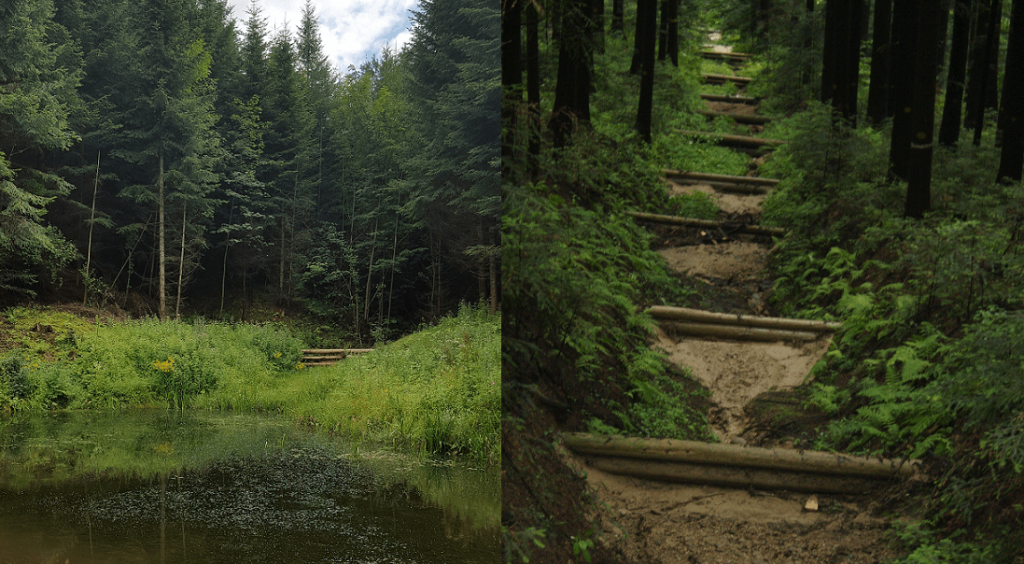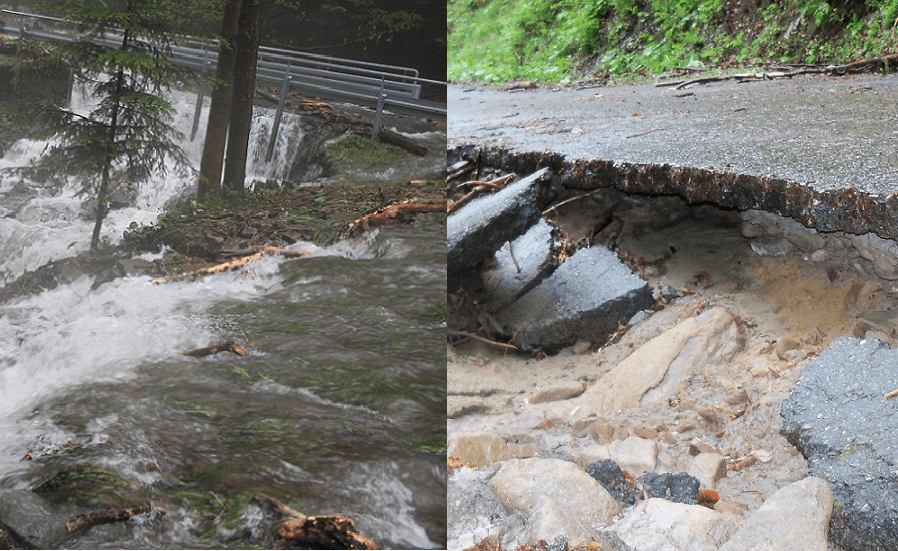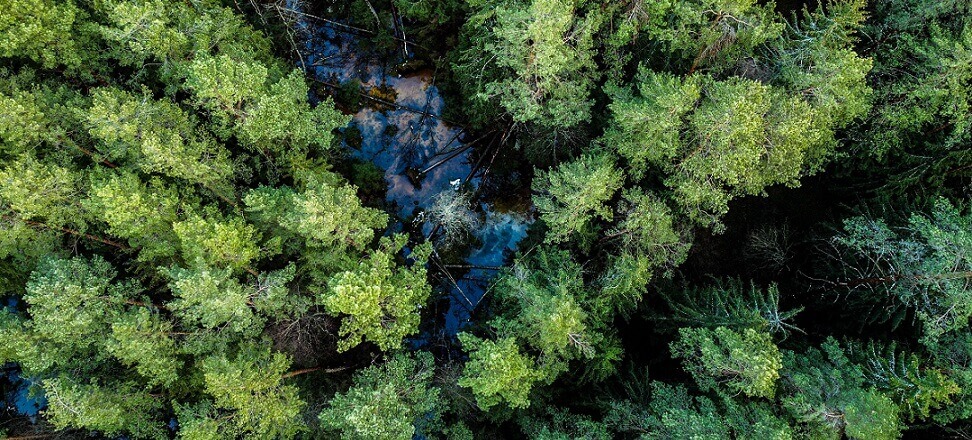State Forests undertake activities known as small-scale retention – they promote the retention or slowing of water runoff without too much interference with the natural landscape. One of the pioneers of this initiative in Poland is Paweł Szczygieł, director of the Regional Directorate of State Forests in Cracow. This article is the story of how, given limited resources, lack of advanced technology and ready-made solutions (if only by design), a group of enthusiast foresters, headed by their director, implemented pioneering solutions for mountain retention in the broadest sense.
Small retention – beginnings in Poland
Small-scale retention, implemented without prior, multi-phase preparation, has become a benchmark for developing model water retention solutions in cooperation with design offices and architects’ associations.
During the implementation of pioneering solutions, a synergistic effect, as it were, was triggered – the cooperation of Malopolska foresters with designers contributed to the creation of a number of solutions based on nature, i.e. those that need local, naturally occurring raw materials – wood and stones – for implementation. It is worth noting that these solutions are used all the time within the framework of small-scale mountain and lowland retention projects implemented by the Forests, and their scope goes far beyond forest management and focuses on processes that support adaptation to climate change.
Advantages of small-scale retention
The effect of the project activities is to generally mitigate the effects of the already widespread lowering of groundwater levels, to supply the forest with life-giving water and improve the water balance, and thus to have a positive impact not only on the functioning of the entire forest ecosystem, but also on adjacent areas (including elements of the agricultural landscape).
Small-scale retention contributes to increasing the moisture content of forest habitats by raising the groundwater table in areas adjacent to reservoirs, significantly increasing biodiversity in the adjacent forest. Small-scale retention also has a beneficial effect on hydrogenic habitats, i.e. water-dependent peatlands, alders and riparian forests.
Small mountain retention, or rather anti-erosion and water retention measures in the environment, is not only about improving the safety of local communities in terms of access to good quality water, but also about safe road infrastructure of mountain areas.

a
The role of small-scale retention in Poland
The lowland and upland areas of Poland today are among those characterized by very unfavorable hydrological relations. This is due to low annual precipitation (about 650 mm on average), high terrain evaporation (450 mm) and a small share of river inflow from outside the country (13 percent). The large water deficit is compounded by a modest network of natural surface water, that is, rivers, lakes and marshes, which account for only 2.6 percent. Poland’s surface area. The capacity of artificial retention reservoirs is small, yielding 6.5 percent. annual water runoff.
Wetlands, marshes, bogs, wet meadows and forests occupy about 14 percent. The surface of our country. What’s more, the warming climate projected over the next decades will clearly increase evaporation. With the current amount of precipitation, this will lead to a further worsening of the water deficit. Also a problem in this context is the increasing urbanization and development of green spaces, which accelerates water runoff into rivers and seas. From this perspective, increasing retention capacity and improving the water balance become one of the most important environmental tasks of the future. Small-scale retention may be the key to solving at least some of the problems.
Forested areas, which in the mountains generally occupy the upper zones of catchment areas and areas with the greatest gradients, have an important role to play. Forest cover there increases soil water infiltration, recharges groundwater supplies, and reduces the volume and rate of surface runoff and flood risk. In the lowlands, forests have been preserved in areas less suitable for farming, often due to the presence of swamps, marshes and wetlands. At the same time, these are the sites with the greatest retention potential. These natural water reservoirs are a very important part of the hydrological system that stabilizes water relations over vast areas.
Water retention once and today
In the past, the area of wetlands was much larger than it is today. In colder climates, water scarcity marked itself less frequently, and periods of drought were not as prolonged. The snow cover lingered for a long time. Its presence eliminated direct evaporation from the soil, and water from slowly melting snow rebuilt groundwater supplies. Spring and early summer drought phenomena were rare. Therefore, in forest areas, measures to regulate water relations and drain excess water (land reclamation) were more common than water storage. In the mountains, meanwhile, the focus was on building infrastructure to limit the destructive power of streams and creeks: steps, sills and strengthening banks.
That’s how it used to be…Today the State Forests are implementing a number of projects aimed at water retention and the protection of wetland ecosystems. Environmental changes have forced a modification of the course of action. In addition to investments to protect forest infrastructure from the destructive effects of water, numerous facilities are being built to increase the retention potential in forest areas.
Currently, we can confidently call the solutions implemented by the State Forests a model. They are complimented by our Western neighbors (and not only), and projects implemented by LPs receive recognition from the European Commission.
However, the effects we (we, the forest, the environment and the climate) are experiencing today, thanks to the implementation of comprehensive water retention solutions, would not have happened if not for the commitment of passionate foresters. Their excellent knowledge of the forest, the topography of the land, a range of ecosystem relationships and spatial imagination have become the basis from which architects and designers involved in the construction of reservoirs draw.

a
Small retention through the eyes of an expert
Pawel Szczygiel – a child of the forest – has always been connected with the forest. Today he says with unprecedented modesty and humility that he is not the originator of the solutions, that the forest was his teacher and mentor.
What has this forest taught me? Or did we teach each other? It’s a continuous process in which we learn from each other: respect, thinking, problem-solving action, how to take a few steps forward to realize a plan, including an economic one. With the effort we make every day, we can enjoy the satisfaction and joy of visible and beautiful results that serve society.
This forest, my forest, taught me that it is worthwhile to draw knowledge from the cheapest source – from the experience of predecessors, taught me to look at the achievements of entire generations of foresters, but also of individual, unexceptional individuals. Experience is an invaluable treasure trove of guidance, signposts from which we should draw and which make a lot easier.
And so it was and is with this water in the forest….
The beginning of my professional work in the Forests was in the mid-1990s, when political and economic transformations made it necessary to learn a new reality, especially in the area of carrying out forest management work, construction and maintenance of road and engineering infrastructure (privatization of the service sector). Mountain forests, which have become a school of life for me, generally occupy the upper zones of the catchment area and cover areas with the greatest gradients, which means that forest management requires a lot of effort and ingenuity.
In that reality, very often, due to limited funds, we were forced to build engineering structures (culverts, bridges, fords) or make fortifications and developments on watercourses (cascades, thresholds, cascades or small reservoirs) aimed at securing road infrastructure. so-called. economic system. More often than not, we had the project in our heads, and used natural and local material, namely wood and boulders, rocks or rock rubble. A sneak peek at the simplicity of workmanship and effectiveness of, for example, stone and wood baskets provided, and often still does, a guarantee of good slope and embankment reinforcement.
The homesteading designs of those years are the basis for solutions and construction guidelines today.
Projects supporting small-scale retention
In 1997. The Director of State Forests has approved the “Principles for Planning and Implementation of Small-scale Retention in State Forests.” The implementation of this program included the construction of small reservoirs and the construction of damming structures on watercourses located in forested areas. Between 1998 and 2005, 1124 such structures were constructed with a total volume of 8.4 millioncubic meters. Expenditures for the implementation of small-scale retention in forests mainly included funds from the State Forests with the support of the WFOŚiGW, EcoFund and foreign funds.
In 2010-2015, the State Forests initiated the project “Increasing retention capacity and counteracting flood and drought in lowland forest ecosystems”, financed by its own funds and the Infrastructure and Environment program. As a result, 3644 facilities were built, including small water reservoirs, damming structures (thresholds, levees), fords and culverts. Within the framework of this project, 31 facilities have been built on the territory of the RDSF in Krakow: reservoirs, monks and dams, which in total allows for the retention of about 225,000 m.3 water.
In parallel, the State Forests implemented a project called: “Counteracting the effects of rainwater runoff in mountainous areas. Increasing retention and maintaining streams and related infrastructure in good condition”. The project was financed from the LP’s own funds and the Infrastructure and Environment program (European Union Cohesion Fund). In 2011-2015, 3553 objects were made in 55 forest districts in 4 regional directorates of the Polish State Forests, mainly using natural materials and the existing terrain. In the Regional Directorate of State Forests in Krakow, 12 forest districts participated in the project, where 610 new facilities were built, allowing retention of a total of about 115 thousand m.3 water.
The second phase of activities co-financed by EU funds under the projects “Comprehensive project for the adaptation of forests and forestry to climate change – small-scale retention and counteracting water erosion in lowland areas” and “Comprehensive project for the adaptation of forests and forestry to climate change – small-scale retention and counteracting water erosion in mountain areas” is currently being completed. Their implementation allows retention throughout the LPs of approx. 2.5 millionm3, including about 42.6 thousandm3 of water in RDSF Krakow.
By restoring and protecting wetlands, there is a chance to improve habitat quality and population conditions for many highly specialized species of flora and fauna.
Implementation of the project will not only affect local biodiversity, but will also contribute to climate change adaptation and protection against floods and droughts.
Every good story ends with a moral. Pawel Szczygiel aptly summed up his professional daily life:
It’s worth working together, and it’s worth showing maturity by putting our trust in the people we challenge, set goals and targets for.
At the center should be a man with competence adequate to the challenges he faces, a man to whom we should give two things: wings and roots. Especially now, when professionals are hard to come by, and professional enthusiasts are an almost extinct species.
Forestry is quite a special industry, rooted in tradition, knowledge passed down from generation to generation, but also based on the latest scientific reports.
And it is worth remembering that professionalism is never a coincidence. Passion breeds professionalism. Professionalism yields quality. And quality is a luxury in life.
And this is the luxury I wish for myself and for you who are reading this material.
Photo author: Pawel Szczygiel

 Polski
Polski






